This task shows how to create an User-defined Restraint on a geometry.
User-defined Restraints are generic restraints allowing you to fix any combination of available nodal degrees of freedom on arbitrary geometries. There are three translation degrees of freedom per node for continuum element meshes, and three translation and three rotation degrees of freedom per node for structural element meshes.
User-defined Restraint objects belong to Restraints sets.
(this is an example)
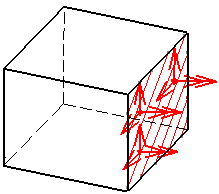
![]() means that there is no translation degree of freedom left in that
direction.
means that there is no translation degree of freedom left in that
direction.
![]() means
that there is no rotation degree of freedom left in the direction.
means
that there is no rotation degree of freedom left in the direction.
-
User-defined Restraints can be applied to the following types of supports:
|
Geometrical Feature |
Mechanical Feature |
Analysis Feature |
||||
|
Spatial Groups |
Geometrical Groups |
Groups by Neighborhood |
Groups by Boundary |
Others |
||
|
Point/Vertex |
|
|
|
|
|
Virtual Part |
To know more, refer to Authorized Supports.
-
Make sure you fixed all the global degrees of freedom of your assembly, otherwise a global singularity will be detected at the time of the Static Computation (such a model is unsolvable). To allow you to easily correct the model (Static Analysis Cases only), the singular displacement of the assembly will be simulated and visualized after computation.
Open the sample20.CATAnalysis document from the samples directory.
-
Go to View > Render Style > Customize View and make sure the Shading, Outlines and Materials options are active in the Custom View Modes dialog box.
-
Click User-defined Restraint
 in the Restraints toolbar.
in the Restraints toolbar.The User-defined Restraint dialog box appears.
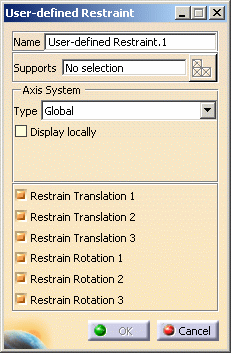
- Name: lets you modify the name of the restraints.
- Supports:
- Select Mesh Part: to know more about the Select Mesh Part button, refer to Selecting Mesh Parts.
- Axis System: lets you choose between Global,
Implicit and User-defined Axis systems for
defining the degrees of freedom directions:
- Global: if you select the Global Axis system, the degree of freedom directions will be interpreted as relative to the fixed global rectangular coordinate system.
- Implicit: if you select the Implicit Axis system, the degree of freedom directions will be interpreted as relative to a local variable coordinate system whose type depends on the support geometry.
- User: if you select a User Axis system,
the degree of freedom directions will be relative to the
specified Axis system. Their interpretation will further
depend on your Axis Type choice.
To select a User-defined Axis system, you must activate an existing Axis by clicking it in the features tree. Its name will then be automatically displayed in the Current Axis field.
If you select the User-defined Axis system, the Local orientation combo box further allows you to choose between Cartesian, Cylindrical and Spherical Local Axis Orientations.- Cartesian: the degrees of freedom directions are relative to a fixed rectangular coordinate system aligned with the cartesian coordinate directions of the User-defined Axis.
- Cylindrical: the degrees of freedom directions are relative to a local variable rectangular coordinate system aligned with the cylindrical coordinate directions of each point relative to the User-defined Axis.
- Spherical: the degrees of freedom directions are relative to a local variable rectangular coordinate system aligned with the spherical coordinate directions of each point relative to the User-defined Axis.
To know more about axis system, refer to Axis System Type.
- Degrees of freedom: lets you fix up or release degrees of
freedom.
You can fix up or release six degrees of freedom per node:
- Translation 1 = Translation in the x-direction
- Translation 2 = Translation in the y-direction
- Translation 3 = Translation in the z-direction
- Rotation 1 = Rotation in the x-direction
- Rotation 2 = Rotation in the y-direction
- Rotation 3 = Rotation in the z-direction

If you select the Restrain Rotation check boxes, make sure the selected elements can actually be restrained at given rotations.
-
If needed, change the name of the user-defined restraint.
-
Select the desired Axis System Type.
-
Select the support.
Any selectable geometry is highlighted when you pass the cursor over it.
You can select several supports in sequence, to apply the User-defined Restraint to all supports simultaneously.
Symbols representing fixed degrees of freedom in all restrained directions for the selected geometry are visualized.By default, all the degrees of freedom are fixed up:
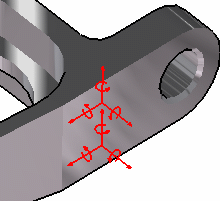
-
Fix up or release degrees of freedom.
-
To fix up a degree of freedom, select the corresponding check box.
-
To release a degree of freedom, clear the corresponding check box.
Examples:
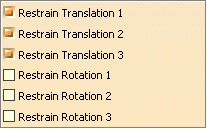
The corresponding symbols are displayed:
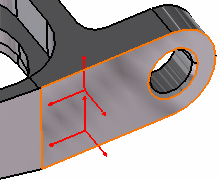

The corresponding symbols are displayed:

-
-
Click OK.
A User-defined Restraint object appears in the specification tree under the active Restraints objects set.

- You can either select the support and then set the User-defined Restraint specifications, or set the User-defined Restraint specifications and then select the support.
- If several Analysis Cases have been defined in the Finite Element Model, you must activate a Restraints objects set by clicking it in the features tree before creating an User-defined Restraint object.
- Restraints are required for Stress Analysis computations. They are optional for Modal Analysis computations (if not created, the program will compute vibration modes for the free, unrestrained part).
- User-defined Restraint objects can be edited by a double click on the corresponding object or icon in the features tree.
The ELFINI Structural Analysis product offers the following additional functionalities:
-
Contextual menu on the restraint object:
- Restraint visualization on mesh:
the translation of the restraint specifications into solver
specifications can be visualized symbolically at the impacted mesh nodes,
provided the mesh has been previously generated using a mesh only
computation.
To know more, refer to Visualizing Restraints on Deformed Mesh.
- Restraint visualization on mesh:
the translation of the restraint specifications into solver
specifications can be visualized symbolically at the impacted mesh nodes,
provided the mesh has been previously generated using a mesh only
computation.
- Contextual menus on the restraints set:
- Generate Image: generates an image on the computed
restraints set (along with translating all user-defined restraints
specifications into explicit solver commands on mesh entities), by
generating symbols for the nodal restraints imposed by the restraints
sets. The image can be edited to include part or all of the
options available.
To know more, refer to Generating Images. - Report: the partial status and results of intermediate pre-processor computations are reported in HTML format. It represents a
subset of the global report capability and generates a partial report of
the restraints set computation.
To know more, refer to Generating Reports.
- Generate Image: generates an image on the computed
restraints set (along with translating all user-defined restraints
specifications into explicit solver commands on mesh entities), by
generating symbols for the nodal restraints imposed by the restraints
sets. The image can be edited to include part or all of the
options available.
![]()